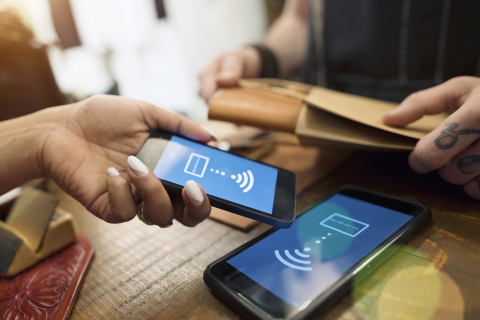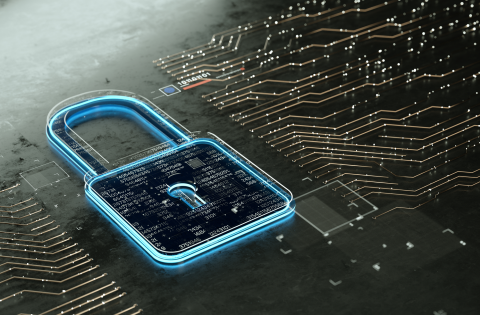
NFC technology enables contactless payments using a smartphone or payment card almost anywhere, from the supermarket check-out line to the parking garage. And wireless technologies offer an ever-widening range of possible applications, for example use in digital keys for the Smart Home and soon in charging smaller devices.
What is NFC?

The abbreviation NFC stands for Near Field Communication: This wireless technology transmits data over short distances of no more than about four centimeters – by contrast, Bluetooth and WLAN are capable of data communication over distances of up to 100 meters, depending on the device in question.
NFC is frequently used in supplement to Bluetooth and WLAN, since it can couple two devices faster. This is because NFC functions as a kind of key, replacing the need to pair Bluetooth devices or enter a WIFI password. One major advantage of NFC in this context is therefore its ability to rapidly establish a connection, taking only one tenth of the time Bluetooth requires to complete pairing.
In 2004 vendors Nokia, Philips and Sony introduced an internationally valid NFC transmission standard. The associated NFC Forum defines the specifications and makes improvements as necessary. For several years Infineon has been centrally involved in the strategic and technical orientation of the NFC Forum as a Sponsor Member.
How does an NFC chip work?

The NFC chip works in combination with a rolled antenna. This spiral generates an electromagnetic field which NFC chips can use for wireless communication of data via inductive coupling. This data often includes telephone numbers, links, contacts and access data. The device receiving the data is given access and receives instructions on what it should do with the data – for example make a phone call to someone, open a web page, store data or establish a data connection.
In general NFC chips work a passive or active mode. However, they only generate an electromagnetic field when in the active mode. This electromagnetic field can be used not only for data transmission, but also to generate electricity. When a device is held close to an NFC tag, the magnetic field in the active chip generates a voltage in the coil of the passive chip. Today the majority of NFC transactions take place in passive mode, i.e. without an additional power supply in an NFC card or a wearable device. Another inherent benefit is the low level of power consumption, a highly important aspect for long battery cycles in consumer devices.
Active tags vs. passive tags
Examples of devices with active tags:
- Reader terminals in retail stores
- Smartphones
- Wearables such as smartwatches
Examples of devices with passive tags:
- Credit cards
- Bank cards and debit cards
The most important facts at a glance
- Transmission frequency: 13.56 MHz
- Data transmission speed: 424 KBit/s (by way of comparison: Bluetooth 4.0 transfers data at up to 25 Mbit/s)
- NFC chip data storage: 2,048 bytes
What do we need NFC for?

NFC technology is a convenient, straightforward way to establish communication between two devices. There is a wide range of practical applications for this type of communication:
Contactless payments with NFC
Today NFC is most commonly used for contactless payment. In addition to smartphones, more and more credit cards and other payment cards feature NFC technology. As a rule banks and credit card companies issue new credit cards exclusively with NFC chips. According to The German Banking Industry Committee, 75 million of the 100 million bank cards in Germany are equipped with NFC chips. Those that are not will be replaced when the older cards expire, by no later than 2022.
Contactless payment is possible both with cards and with smartphones, for example at gas stations and in supermarkets, where the customer simply holds the telephone or card against a card reader. This is more convenient and faster than having to insert the card in the reader and then use the keypad to enter a PIN. A PIN is no longer required for smaller amounts, with the upper limit ranging from 25 euros to 50 euros, depending on the European country in question.
Contactless payment in transactions for amounts over this limit usually require the entry of a PIN or the customer's signature for authentication. The smartphone also supports contactless payment of larger amounts without PIN via the NFC interface, as long as the smartphone also has a biometric authentication feature. This requires a payment app such as Google Pay or Apple Pay which has to be supported by the user's bank. In the USA there is no transaction limit, although a signature is sometimes required for larger amounts.
Contactless payments using NFC have already been common for quite some time in many countries, for example in the USA, China, Singapore, Canada and the United Kingdom. The Corona pandemic has made contactless payments all the more widespread, even in countries such as Germany which had been hesitant in the past. The advantage: The customer and the merchant are no longer required to touch cash or the card terminal during payment, reducing the danger of transmitting viruses.
In many cities around the world, passengers in public transportation can now pay by NFC at special touchpoints. A wireless connection then sends the ticket directly to the device used to pay, for example a credit card format, smartphone or wearable. The conductor can then check the ticket with a reader.
Passengers travelling with the Spanish airline Iberia can use biometric data and an NFC ticket stored on their telephones to identify themselves at the boarding gate. Electronic tickets using NFC are expected to replace more and more paper tickets in the future, for example in movie theaters and at concerts.
Other NFC applications
1. Digital keys:
In addition to contactless payment, NFC technology can also be utilized in the Smart Home. Users can unlock and open house doors with NFC-capable devices without using a physical key. One advantage of this kind of key is that it can easily be shared with other participants. Since physical duplicates are no longer necessary, the user retains more control over the keys.
Here the matching lock is equipped with an NFC tag which is identified by the smartphone, a wearable or another token. Many companies use this function for example to limit building access to authorized employees. And NFC technology is on the job in digital car keys as well, for example in several Mercedes-Benz, BMW and Hyundai models.
Our Discovery will tell you more about the possibilities of Smart Buildings, the corporate buildings of the future.
2. Representing information:
Although still rather rare, there are also advertising posters and places of interest equipped with NFC tags that provide relevant information on the smartphone at the user's request. For example, if held up to an NFC-capable poster advertising a concert, the telephone can then open a web page where a ticket can be purchased.
3. Streaming content:
Users can exchange data between devices using NFC, as well as links and contact information. When televisions, cameras and music systems are made NFC-capable, the smartphone display can be mirrored to the TV screen and photos can be transferred from the digital camera to the smartphone.
4. Digital business cards:
And there are even more ways to integrate NFC technologies in our everyday lives and Smart Homes. Individual commands and functions can be programmed on write-capable tags in the form of stickers or pendants. For example, the users can store WIFI access data or their business cards on the tag. When a visitor holds his smartphone up to the tag, he is automatically logged into the network. It's not even necessary to open the phone's camera to do so, as with a QR code.
5. Charging:
It will soon be possible to use NFC to charge small accessory devices such as Bluetooth headsets by simply placing the devices close to the smartphone. The NFC Forum published a new standard for this application in May 2020, referred to as the Global Wireless Charging Standard. Here power levels of up to 1 watt are possible.
RFID versus NFC: Common aspects and differences

NFC is based on RFID protocols and is a further development of RFID. RFID (Radio Frequency Identification) makes it possible for users to identify and authenticate themselves automatically and contact-free. There have been RFID chips in German passports since 2005, and in German national identity cards since 2010. RFID chips can also be used to trace missing pets, as long as a chip has been implanted in the animal first.
Similar to NFC, RFID makes it possible to communicate between a reader and a tag. But there are also differences between the two technologies: Two devices can only communicate with each other and exchange data using NFC. This is for example the prerequisite for pairing Bluetooth devices. RFID always supports communication in only one direction: An RFID chip can only be either a transmitter or a receiver, but not both.
How secure is NFC?

Data transmission using NFC is considered more secure than data transmission over Bluetooth or WIFI. This is a result of the very short range of the NFC tag, only a few centimeters. Attacks and data theft are theoretically possible with a great amount of effort, but the attacker would have to be in the user's immediate vicinity and would have to carry a reader, which is in practice a highly unlikely scenario. Furthermore, a data thief would only be able to intercept the information stored on the chip and as it is being transmitted; even then, this would only be the case if the transmission was unencrypted, which is only rarely the case.
Many possible applications are secure: Data in peer-to-peer communication are generally transmitted between two devices in secure encrypted form. When paying via NFC, the user's real bank data are not sent to the reader; instead an encrypted copy is sent. Thus anyone who could intercept the data would find it useless.
Things can however become difficult when criminals manage to get a hold of a credit card with an NFC tag. However, the criminals would only be able to make small transactions with the card, since personal authentication is necessary for larger transaction amounts. And users should also be careful when reading NFC tags from unknown sources, which could lead to infection by malware.
In the future there will be more and more solutions in which data are transmitted in encrypted form via NFC and where users are identified based on biometric characteristics such as fingerprints or facial recognition. Biometric payment cards are also being developed – using chips made by Infineon.
Infineon's role with NFC chips

Infineon is one of the world's largest manufacturers of NFC chips and antennas, delivering the majority share of all security chips used in payment cards. And that's not all: Thanks to Infineon's contactless payment solutions almost any device can be turned into a payment solution, including for example pieces of jewelry like smart rings, armbands and chains.
Because of their small dimensions, boosted NFC solutions from Infineon are optimized for Smart Wearables and Internet of Things devices, where as a rule there is limited space for installing chips. The SECORA Connect microcontroller is made specifically for wearables and among other things makes it possible to pay with wearable devices. In addition, Infineon makes microcontrollers for passive NFC tags as well.
Infineon consistently relies on system solutions with integrated operating systems. This lets manufacturers realize cost-efficient implementations in a quick and agile manner. In addition to SECORA Pay and SECORA Connect for secure payments with cards and wearables, Infineon also offers solutions like SECORA ID which combine security chips and matching software with the GovID project. These solutions support both contact-based and contactless solutions and are in use in a variety of electronic identity documents. The microcontroller in the corresponding solution supports encryption and stores biometric data.
Last update: March 2022



